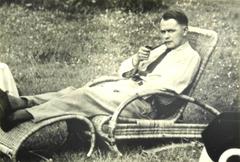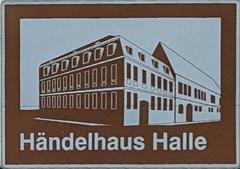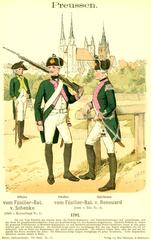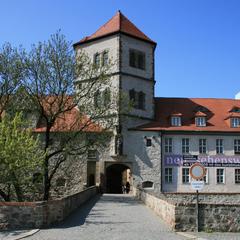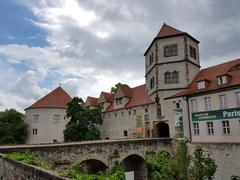
Landgericht Halle Visitor Guide: Visiting Hours, Tickets, and Historical Highlights
Date: 03/07/2025
Introduction
The Landgericht Halle, located in the heart of Halle (Saale), Saxony-Anhalt, is both a functioning regional court and an architectural gem reflecting Germany’s legal and cultural heritage. Built between 1901 and 1905 during the Wilhelmine era, its imposing Late Gothic and Early Renaissance design—featuring a striking sandstone façade, twin towers, and a grand double-helix staircase—makes it a centerpiece of Halle’s urban landscape and a symbol of judicial authority (Landgericht Halle official site; International Architecture Awards). The building’s extensive restoration from 2010–2013 ensured the preservation of its historic elements, while seamlessly integrating contemporary judicial facilities and accessibility improvements (TCHOBAN VOSS Architekten).
This guide provides comprehensive, up-to-date information on the Landgericht Halle’s history, architecture, visiting hours, ticketing, accessibility, etiquette, and nearby attractions, ensuring a rewarding experience for travelers, architecture enthusiasts, and those interested in German legal culture.
Table of Contents
- Introduction
- Historical Development
- Architectural Significance
- Landgericht Halle’s Role in Halle’s Identity
- Practical Visitor Information
- Restoration Highlights
- Modern Judicial Functions
- Visitor Etiquette and Local Customs
- Frequently Asked Questions (FAQ)
- Conclusion & Final Tips
- References
Historical Development
Landgericht Halle’s origins date back to the early 20th century, a period of rapid civic expansion in Germany. Constructed between 1901 and 1905, the building was designed to symbolize the rule of law and the German Empire’s commitment to justice through monumental architecture (International Architecture Awards). It initially served as a higher regional court, positioned between the local Amtsgerichte and the Oberlandesgericht Naumburg, and continues to function as a regional court today.
Architectural Significance
Exterior and Urban Context
The four-story courthouse dominates its conservation area, blending Late Gothic and Early Renaissance elements. Its sandstone façade, pointed arches, and twin towers are emblematic of Wilhelmine-era public buildings, intended to project gravitas and institutional stability (International Architecture Awards).
Interior Features
Inside, the highlight is the grand double-helix staircase beneath a domed rotunda, exemplifying the period’s attention to spatial drama and ornamentation. Original stained glass, wood paneling, and decorative plasterwork can be admired throughout, offering a window into early 20th-century craftsmanship.
Conservation and Modern Use
Listed as a protected monument, the Landgericht Halle underwent a major restoration from 2010–2013, led by Tchoban Voss Architekten. Restoration focused on preserving historical elements—façade, towers, statuary, and interiors—while integrating modern amenities, safety systems, and accessibility features (TCHOBAN VOSS Architekten).
Landgericht Halle’s Role in Halle’s Identity
Symbol of Civic Authority
More than a judicial institution, the Landgericht Halle is a symbol of Halle’s legal tradition and civic pride, anchoring the city’s administrative and cultural landscape (Lund University Paper).
Cultural Heritage and Tourism
As a prime example of Wilhelmine architecture, the courthouse draws architecture buffs, history enthusiasts, and cultural tourists. Its central location makes it an ideal launching point to explore the Marktkirche Unser Lieben Frauen, Moritzburg Castle, and Handel House (Germany Travel: Halle; Try Travel: Halle Saale).
Practical Visitor Information
Visiting Hours and Tickets
- General Opening: Monday–Friday, 8:00 AM–4:00 PM. Closed weekends/public holidays.
- Public Access: Free to exterior and select public interior spaces during official hours; courtroom access may be restricted due to proceedings.
- Guided Tours: Special guided tours (e.g., “Gerichts-Tour: Im Namen des Volkes”) are offered on the first Saturday of each month at 14:00, for €14 (€12 reduced). Tours are primarily in German, with English by arrangement. Tickets are sold at the Tourist Information Centre and at the meeting point (halle365.de event info).
- Special Events: Free guided tours are available during “Tag des offenen Denkmals” (Open Monument Day) and other local heritage festivals.
Accessibility
- Wheelchair Access: Ramps and elevators provide access to major public areas. Accessible restrooms are available.
- Visitors with Disabilities: Advance notice is recommended to arrange for special needs (official accessibility overview).
Visitor Guidelines and Photography
- Security: Airport-style security screenings are in effect. Arrive early and bring ID.
- Photography: Permitted for the exterior; restricted inside except during special events or with permission.
- Dress Code: Smart-casual or formal attire is recommended; avoid overly casual clothing.
- Etiquette: Maintain silence in courtrooms, be punctual, and address staff with courtesy (“Guten Tag,” “Sie”).
City Tours and Nearby Sites
Combine your visit to the Landgericht Halle with other key sites:
- Marktplatz (town square)
- Moritzburg Castle (art museum)
- Handel House (music history)
- Francke Foundations (Baroque complex)
- Botanical Garden/Ziegelwiese Park for relaxation
All are within easy walking distance or accessible by tram. Parking is available in front of the Justizzentrum, with public transport stops nearby.
Restoration Highlights
- Façade & Towers: Careful cleaning and repair preserved stonework and statuary (Wikipedia: Landgericht Halle).
- Grand Staircase: Restored to original splendor, with updated lighting and safety.
- Modernization: Discreet integration of IT, accessibility, and fire protection while maintaining historical authenticity (World-Architects).
Modern Judicial Functions
The Landgericht Halle is central to the region’s legal system, handling civil and major criminal cases, appeals, and special legal matters with the support of modern technology (Gerichte und Staatsanwaltschaften).
Visitor Etiquette and Local Customs
- Formality: Use polite greetings, maintain quiet in public areas, and respect local dress norms.
- Language: Most proceedings are in German. Some staff speak English; basic German phrases or a translation app are useful.
- Security & Safety: Be vigilant with belongings and follow staff instructions. Gifts are not customary in the courthouse.
Frequently Asked Questions (FAQ)
Q: What are the visiting hours?
A: Monday–Friday, 8:00 AM–4:00 PM. Closed weekends and holidays.
Q: Are tickets required?
A: No for general public areas; yes for guided tours and special events.
Q: Is the building accessible?
A: Yes, with ramps, elevators, and accessible restrooms.
Q: Can I take photos inside?
A: Exterior photography is allowed; interior photography is restricted.
Q: How do I book a guided tour?
A: Via the Tourist Information Centre or at the meeting point; advance booking is recommended.
Conclusion & Final Tips
The Landgericht Halle stands at the crossroads of history, architecture, and civic life—offering a unique glimpse into German judicial culture and urban heritage. Plan your visit during opening hours, book a guided tour for in-depth exploration, and combine your trip with nearby historical sites for a rich cultural experience. For updates on special events and visitor information, check official resources and download the Audiala app.
We look forward to welcoming you to the Landgericht Halle for an engaging and memorable visit!
References
- Landgericht Halle official site
- International Architecture Awards
- TCHOBAN VOSS Architekten
- Germany Travel: Halle
- Try Travel: Halle Saale Guide
- Wikipedia: Landgericht Halle
- halle365.de Gerichts-Tour Event
- Tourist Information Halle
- World-Architects: Restoration
- Accessibility Overview
- Studying in Germany: German Culture


